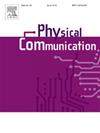A switched full duplex MIMO architecture with digital linear and nonlinear cancellation
IF 2
4区 计算机科学
Q3 ENGINEERING, ELECTRICAL & ELECTRONIC
引用次数: 0
Abstract
Enabling full duplex (FD) in MIMO systems is challenging due to increased hardware complexity and increased training overhead required for canceling not only self-interference (SI) but also cross-link-interference (CLI) signals, considering both linear and nonlinear effects on each stream. In this paper, we propose switched FD MIMO (FD-SW-MIMO) architecture as a low-complexity, low-overhead solution, which enables stream-based nonlinear estimation to be performed independently from channel estimation, so that those nonlinear reference signals are fed to linear SI and CLI cancellation stages. For improved performance at high transmit power levels, the Random Fourier Features - Least Mean Squares (RFF-LMS) algorithm is employed on the residual SI and CLI signals per stream. Our experiments conducted on a software-defined radio based 2x2 FD MIMO test setup reveal that the proposed FD-SW-MIMO architecture can provide up to 12 dB enhancement over linear only digital cancellation. The proposed architecture requires only minor hardware modification(s), avoiding active analog cancellation circuitry and extra Tx/Rx chains. Requiring the same training overhead as linear only cancellation, FD-SW-MIMO architecture can quadruple the rate of HD SISO for low to moderate transmit power levels, and for high transmit power levels, the HD SISO rate is tripled due to slightly increased overhead.
具有数字线性和非线性消除功能的交换式全双工多输入多输出架构
在多输入多输出(MIMO)系统中实现全双工(FD)具有挑战性,这是因为硬件复杂性增加,而且考虑到每个数据流的线性和非线性效应,消除自干扰(SI)和跨链路干扰(CLI)信号所需的训练开销也增加了。在本文中,我们提出了交换式 FD MIMO(FD-SW-MIMO)架构,作为一种低复杂度、低开销的解决方案,它能使基于流的非线性估计与信道估计独立进行,从而将这些非线性参考信号馈送到线性 SI 和 CLI 消除阶段。为了提高高发射功率水平下的性能,在每个数据流的残余 SI 和 CLI 信号上采用了随机傅里叶特征-最小均方(RFF-LMS)算法。我们在基于软件定义无线电的 2x2 FD MIMO 测试装置上进行的实验表明,与线性数字消除相比,拟议的 FD-SW-MIMO 架构最多可增强 12 dB。拟议的架构只需对硬件进行少量修改,避免了有源模拟消除电路和额外的 Tx/Rx 链。FD-SW-MIMO 架构需要与仅线性消除相同的训练开销,在中低发射功率水平下,可将高清 SISO 速率提高四倍;在高发射功率水平下,由于开销略有增加,高清 SISO 速率可提高三倍。
本文章由计算机程序翻译,如有差异,请以英文原文为准。
求助全文
约1分钟内获得全文
求助全文
来源期刊

Physical Communication
ENGINEERING, ELECTRICAL & ELECTRONICTELECO-TELECOMMUNICATIONS
CiteScore
5.00
自引率
9.10%
发文量
212
审稿时长
55 days
期刊介绍:
PHYCOM: Physical Communication is an international and archival journal providing complete coverage of all topics of interest to those involved in all aspects of physical layer communications. Theoretical research contributions presenting new techniques, concepts or analyses, applied contributions reporting on experiences and experiments, and tutorials are published.
Topics of interest include but are not limited to:
Physical layer issues of Wireless Local Area Networks, WiMAX, Wireless Mesh Networks, Sensor and Ad Hoc Networks, PCS Systems; Radio access protocols and algorithms for the physical layer; Spread Spectrum Communications; Channel Modeling; Detection and Estimation; Modulation and Coding; Multiplexing and Carrier Techniques; Broadband Wireless Communications; Wireless Personal Communications; Multi-user Detection; Signal Separation and Interference rejection: Multimedia Communications over Wireless; DSP Applications to Wireless Systems; Experimental and Prototype Results; Multiple Access Techniques; Space-time Processing; Synchronization Techniques; Error Control Techniques; Cryptography; Software Radios; Tracking; Resource Allocation and Inference Management; Multi-rate and Multi-carrier Communications; Cross layer Design and Optimization; Propagation and Channel Characterization; OFDM Systems; MIMO Systems; Ultra-Wideband Communications; Cognitive Radio System Architectures; Platforms and Hardware Implementations for the Support of Cognitive, Radio Systems; Cognitive Radio Resource Management and Dynamic Spectrum Sharing.
 求助内容:
求助内容: 应助结果提醒方式:
应助结果提醒方式:


